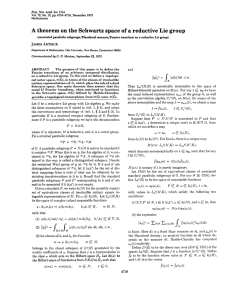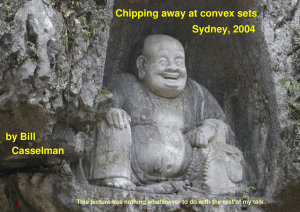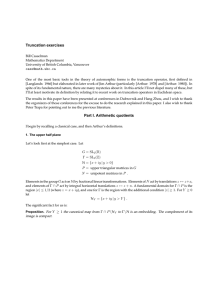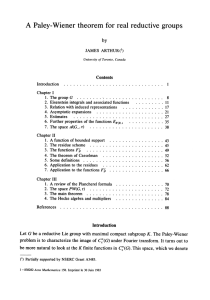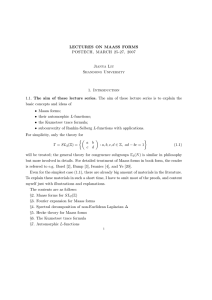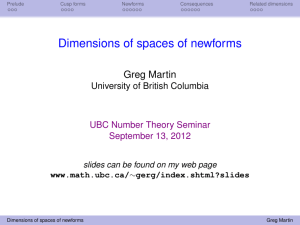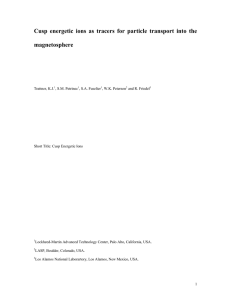Document 11110183
advertisement
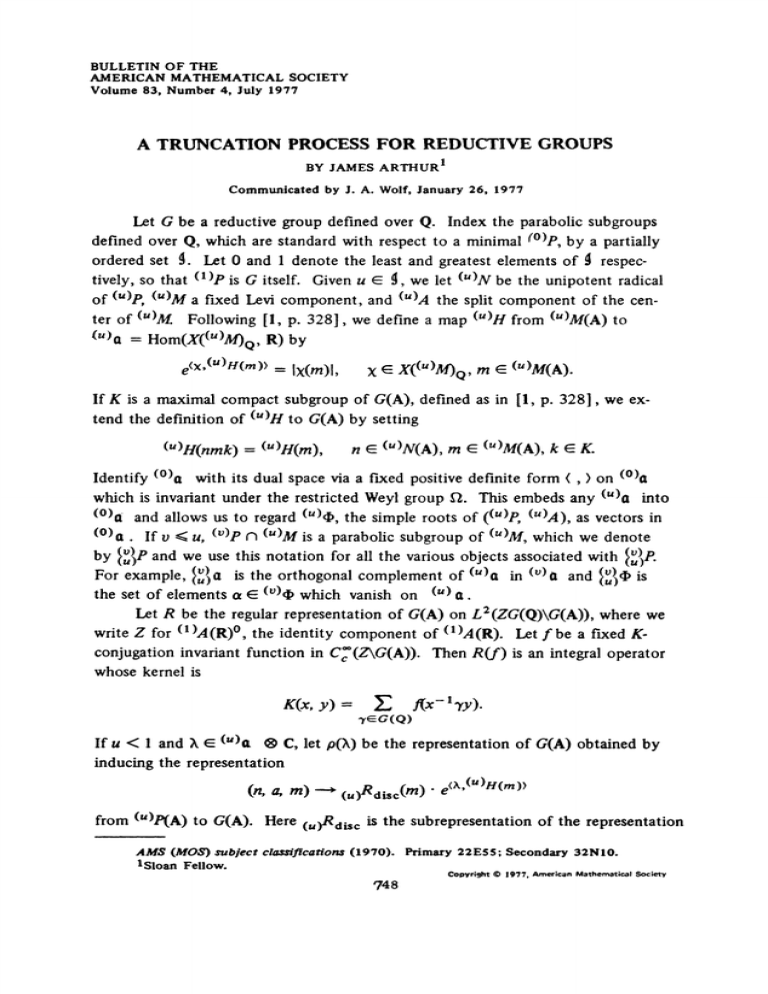
BULLETIN OF THE
AMERICAN MATHEMATICAL SOCIETY
Volume 83, Number 4, July 1977
A TRUNCATION PROCESS FOR REDUCTIVE GROUPS
ARTHUR1
BY JAMES
Communicated by J. A. Wolf, January 26, 1977
Let G be a reductive group defined over Q. Index the parabolic subgroups
defined over Q, which are standard with respect to a minimal (O)P, by a partially
ordered set 4. Let 0 and 1 denote the least and greatest elements of 9 respectively, so that (l)P is G itself. Given u E 9, we let (")N be the unipotent radical
of (u)p, (u)M a fixed Levi component, and (U)A the split component of the center of (u)M. Following [1, p. 328], we define a map (u)H from
to
(u)a
=
(")M(A)
Hom(X((U)M)Q, R) by
ex,(u)H(m)> = Ix(m)l,
xE
X((U)M)Q,
m
E ()M(A).
If K is a maximal compact subgroup of G(A), defined as in
tend the definition of (")H to G(A) by setting
(u)H(nmk) = ()H(m),
ne
[1, p. 328], we ex-
(u)N(A), m E ()M(A), k e K.
Identify (°)a with its dual space via a fixed positive definite form ( ,) on (°)a
which is invariant under the restricted Weyl group Q2. This embeds any (u)a into
(°)a and allows us to regard (u)c, the simple roots of ((u)P, (u)A), as vectors in
(o)a . If v < u, (v)P n (u)M is a parabolic subgroup of (u)M, which we denote
/u°P.
by }")P and we use this notation for all the various objects associated with
For example, u)a is the orthogonal complement of (u)a in (")d and UI> is
the set of elements a E (U)D which vanish on (u) a.
Let R be the regular representation of G(A) on L2(ZG(Q)\G(A)), where we
write Z for
the identity component of
Let f be a fixed Kconjugation invariant function in Cc(Z\G(A)). Then R(f) is an integral operator
whose kernel is
(1)A(R)0,
(1)A(R).
K(x,y)=
yeG(Q)
f(x-1yy).
If u < 1 and X E (u)a 0 C, let p(X) be the representation of G(A) obtained by
inducing the representation
(n, a m)- (u)Rdisc(m) e(X-(u)H(m)
from (u)P(A) to G(A). Here (u)Rdisc is the subrepresentation of the representation
AMS (MOS) subject classifications (1970). Primary 22E55; Secondary 32N10.
1Sloan Fellow.
748
Copyright © 1977, American Mathematical Society
A TRUNCATION
PROCESS FOR REDUCTIVE GROUPS
749
of (U)M(A) on L2(()A(R)0 * (U)M(Q)\()M(A)) which decomposes discretely.
We can arrange that p(X) acts on a fixed Hilbert space (u)H of functions on
(U)N(A) (U)A(R)° · (u)M(Q)\G(A).
*
complement of the
If u = 1, we take (1)H to be the orthogonal
in
forms
the
cusp
subspace of L2(ZG(Q)\G(A)) which decom-
poses discretely.
of (u)H, u E i, such that
)E(0, X, x)E(.,
THEOREM 1. There exist orthonormal bases (u)
KE(xKE(X Y)y)) = £E
(
'U)
i
(p(X, f ',
y)dWl
converges uniformly for x and y in compact subsets of ZG(Q)\G(A). (Here
E(0, * , ) is the Eisenstein series associated with 0 as in [3, Appendix II].) Moreover, Rcusp(f), the restriction of the operator R(f) to the space of cusp forms,
is of trace class, and if the Haar measures dIXl on Xl 3a are suitably normalized,
,
(Q)\G(A)(K(x, x) - KE(x, x)) dx.
tr Rcusp(f) = f
For any u E 9, let (uh) be the basis of (la which is dual to (u)D. We
write lul for the number of elements in (u)D or (u)^. Let (u)^ be the characteristic function of {H E (U)
, , H) > 0, E (u)^). Fix a point T e (O)a such
that (a, T) is suitably large for each ac E (0). Motivated by the results of [2,
§9],we define
:·
(AX)(x) = El (-)l)ul
u 3e
6 e(U)P(Q)\G(Q)
(,(nbx) dn
U)N(Q)\(")N(A)
()((U)H(cx)- 7),
.
for any continuous function 0 on ZG(Q)\$G(A). Let kT(x) and kT(x) be the
functions obtained by applying A to each variable in K(x, y) and KE(X, y) separately, and then setting x = y. If 0 is a cusp form, AO = 0. From this it follows
that
T(X) _(x) = K(x, x) KE(X, ).
-
-
THEOREM 2. The functions kT(x) and kT(x) are both
ZG(Q)\G(A), and the integral of kkT(x) equals
E£
integrable over
E @,sE
() E( , x) · E(¢
Iz(G(Q)\G(A)A
X, x)dxdlX.
t
)
0
It should eventually be possible to calculate the integrals in Theorem 2 by
extending the methods of [2, §9]. On the other hand, kT(x) is not a natural
truncation of K(x, x). This defect is remedied by the following
JAMES ARTHUR
750
THEOREM 3. The function
kt(x)= uEt£ (-I)1"1 5e(u)p(Q)\G(Q)
.uE |(u)N(A)
N A
I £
inx)dn
Ax£
E()M(Q)
(U ")H(Sx) T)
is integrable over ZG(G)\G(A). For sufficiently large T, the integrals over
ZG(Q)\G(A) of kT(x) and kT(x) are equal 0
The proofs will appear elsewhere.
-
REFERENCES
Arthur, The Setberg trace formula for groups of F-rank one, Ann. of Math.
(2) 100 (1974), 326-385. MR S0 #12920.
2. R. P. Langlands, Elsenstein series, Algebraic Groups and Discontinuous Subgroups,
(Proc. Sympos. Pure Math., Boulder, Colo., 1965), Amer. Math. Soc., Providence, R. I., 1966,
235-252. MR 40 #2784.
3. - , On the functional equations satisfied by Eisenstein series, Lecture Notes in
Math., vol. 544, Springer-Verlag, Berlin and New York, 1976.
1. James
DEPARTMENT OF MATHEMATICS, DUKE UNIVERSITY, DURHAM, NORTH
CAROLINA 27706
Current address: School of Mathematics, Institute for Advanced Study, Princeton,
New Jersey 08540





